What Is a Migraine? Symptoms and Treatment Options

Headaches and migraines can be awful and even hinder our ability to function in everyday life, leaving us completely consumed by the pain. But when is a headache no longer a headache? In other words, when are the symptoms so severe that it is no longer a headache but a migraine instead?
What is a migraine?
A migraine is a headache of varying intensity that is often accompanied by nausea and sensitivity to light and sound. While headaches can be tolerable with proper lifestyle changes and medication, a migraine can make it difficult to function properly if left untreated. By understanding the causes and symptoms of a migraine, however, it is much easier to treat migraines and even prevent them from occurring.
Causes
Although the causes of migraines are not completely understood by medical professionals, there are certain life tendencies that tend to increase the risk of developing a migraine, which is typically a genetic condition.
One of the main causes of migraines has to do with consumption. Certain foods, such as those that are high in salt, and drinks such as alcohol and highly caffeinated beverages play a large role in developing a migraine. Also, skipping meals for extended periods of time can lead to the onset of a migraine.
Another common cause of a migraine is stress, which can be either physical or emotional stress. Although the reason migraines are experienced during stressful periods of one’s life is not known, there is certainly a strong correlation between the two.
Symptoms
Many of the symptoms experienced by those who have a migraine are similar to the symptoms associated with headaches, including pain on one or both sides of the head that is throbbing or pulsing.
However, there are symptoms found in migraines that are more serious than the average headache, such as nausea and vomiting, blurred vision, and sensitivity to light. Also, more severe migraines may result in lightheadedness, which puts the individual at a high risk of fainting. Once you have experienced one, you will no longer need to ask, "What is a migraine?"
Depending on which stage a person is in during the migraine experience, the symptoms will differ. If any of the symptoms are experienced, it is important to seek immediate care if medical treatment has not been provided already.
Treatment
The best way to treat migraines is to prevent them from occurring, as they are not easy to treat once they occur. Be sure to avoid foods and activities that increase the chance of developing a migraine, and practice a good, healthy lifestyle that includes a consistent meal schedule and some form of short exercise daily.
Although migraines can be treated through self-care, medications, and therapy to a certain degree, in most cases, it is a matter of simply waiting for the symptoms to subside. With that said, there are measures you can take to reduce the symptoms during an attack and lower the chances of migraines becoming chronic.
Migraine FAQs
Here are answers to common migraine questions. This should help you make more informed decisions about your care and prevention plan.
How do I determine the best migraine treatment for me?
Fortunately, there are medications that are available to treat migraines and reduce their severity after they occur. However, an effective long-term treatment and prevention plan involves much more than medication. During your visit with a medical care provider, the physician can review your symptoms, the frequency of your migraines, lifestyle factors, dietary factors, hereditary information, previous treatments, and other important information to help form the best migraine treatment and prevention plan possible for you.
What are the different types of migraines?
There are three notable types of migraines, which are migraine without aura, migraine with aura, and status migrainosus. Your physician can evaluate for the precise type and treat accordingly during the first visit.
What are effective migraine prevention techniques?
Migraine prevention looks different for every individual. Ultimately, the goal is to identify “migraine triggers” and avoid them as much as possible. This could include missing meals, certain emotional states, excessive sun exposure, etc. Techniques such as biofeedback and massage therapy may help reduce the likelihood of migraines for some patients. A consistent sleep schedule may also help.
Are you considering migraine treatment and a long-term prevention strategy?
Migraines cannot be entirely prevented, but there are ways to minimize your risk long-term. If you are experiencing a severe migraine or frequent migraines that are impacting your ability to focus and function normally, then call us today and schedule a visit.
Get more information here: https://tx-urgentcare.com or call Texas Urgent Care & Imaging Center at (832) 941-1894
Check out what others are saying about our services on Yelp: Read our Yelp reviews.
Recent Posts
Flu shots protect children from common strains of influenza. No one wants to be stuck in bed dealing with the symptoms of this common illness. A flu shot can help prevent complications and reduce the chances of catching the flu in the first place. A primary care or urgent care doctor can further discuss the…
Consulting your primary care physician, or "PCP," regularly can help ensure good health. This typically means every three years for most healthy adults under age 50. After your 50th birthday, annual physicals are advised. But what if you have a minor illness? It can be difficult to tell whether you should visit your PCP. This…
Immunizations are an important part of primary care. Not only can they help prevent illness, but they can also reduce the chance of complications should you get sick. Whether you want to get ahead of flu season or whatever else may come your way, your primary care doctor can provide the vaccinations you need.When many…
A walk-in clinic can provide you with the care that you need without the stress of waiting for an emergency doctor in a crowded room. Receiving immediate care is important whenever you are injured or sick. That is why choosing an urgent care clinic over an emergency room is ideal. Here are the benefits that…


